Web Accessibility with AI: Reducing the Digital Divide
In today’s digital world, web accessibility has become necessary, not optional. Millions of people around the world use assistive technology to access the web. An inaccessible website is a tremendous barrier to individuals with visual, auditory, cognitive or motor disabilities. Artificial Intelligence (AI) is growing and consequently becoming more useful in our endeavour to enhance the accessibility, efficiency, and usability of the web.
What is Web Accessibility?
Web accessibility is the act of creating and designing websites and web applications that any individual can use, irrespective of ability. Examples include:
- Screen reader support for visually impaired persons.
- Keyboard navigation is for individuals who are unable to use a mouse.
- Captioning and transcripts for audio and video.
- Readable content with uncomplicated language and adequate contrast.

Web Accessibility using AI
The Web Content Accessibility Guidelines (WCAG) give a model to make content perceivable, operable, understandable, and robust (POUR principles). Nevertheless, applying these guidelines manually on large websites can be error-prone and time-consuming.
Enter AI: A Game Changer
AI can transform web accessibility by automating difficult tasks, making users more personalised, and detecting barriers at scale. Here’s how:
- AI-Powered Image Recognition
One of the biggest challenges in accessibility is writing useful alt text for images. Computer vision-powered tools such as Microsoft’s Azure Cognitive Services or Google Cloud Vision automatically describe images. For instance:
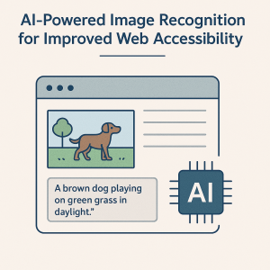
AI Power Image Recognition for improved web Accessibility
A picture of a dog running in a park could be labelled as “A brown dog playing on green grass in daylight.”
This assists screen readers in giving visually impaired users a better experience.
2. Automatic Captioning and Transcription
Automatic tools powered by artificial intelligence, such as YouTube’s automatic captions and Otter.ai’s real-time transcriptions, allow audiences with an auditory impairment to access and interact with video and audio media. Both tools use speech recognition and natural language processing (NLP) to produce an accurate transcript and/or caption.
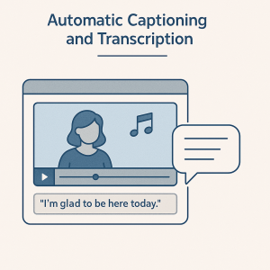
Automatic Captioning and Transcription
3. Voice Interfaces and Chatbots
Web navigation is also aided by voice assistants (like Siri, Alexa, or Google Assistant) and accessible chatbots. People with motor disabilities can use their voice to navigate websites using these technologies. With Natural Language Processing (NLP), AI predicts user intent, and most people can respond in natural language instead of using their hands to navigate a website.
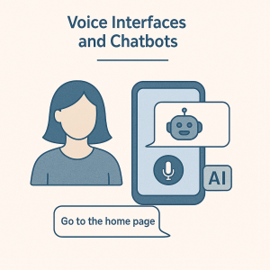
Voice interfaces and chatbots
4. Smart Screen Readers
Conventional screen readers utilise a linear model of reading. AI-powered screen readers, on the other hand, can reorder content according to user activity, context, or document structure. AI models can summarise lengthy articles or point out major highlights, helping users save time and effort.
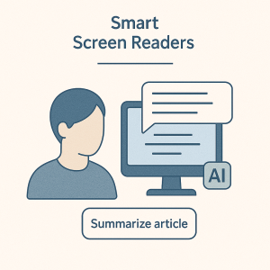
Smart Screen Reader
5. Real-Time Accessibility Testing
AI can check websites for accessibility issues such as lacking alt text, inadequate colour contrast, or ARIA labels broken. Such tools as Axe Accessibility Scanner, Google Lighthouse, and Evinced apply machine learning to highlight possible violations and even propose code-level corrections.
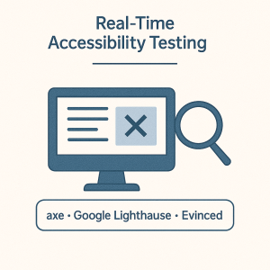
Real-time Accessibility Testing
6. Personalised Accessibility Settings
AI can recognise a user’s pattern of interaction and modify interfaces based on it. For example, if a user wants larger font sizes or more contrast, AI can seamlessly apply these settings to supported sites.
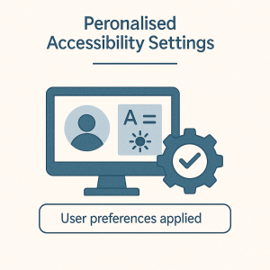
Personalised Accessibility Settings
Challenges & Considerations
Though AI holds immense promise, it’s no silver bullet. These are some things to be careful about:
- Training data bias: If AI is trained on exclusionary datasets, it may misread images or produce biased captions.
- Automation over-reliance: AI should **supplement** human efforts, not automate. Human oversight remains necessary.
- Privacy: AI applications that gather usage patterns for personalisation need to protect user privacy and adhere to legislation such as GDPR.
The Road Ahead
With every advancement in AI, its ability to increase web accessibility will keep increasing. Here are some possibilities for future innovation:
- Emotion recognition for improved content tone adaptation.
- Real-time sign language interpretation.
- AI learning individual accessibility requirements and dynamically adjusting websites accordingly.
Conclusion
Web accessibility is not a nice-to-have technology—it is a human right. AI has a very powerful toolset to make the web accessible to all, but the important thing is being responsible and ethical while using it. Developers, designers, and owners of content should utilise accessibility professionals and users to ensure that any AI-enabled solutions can serve everyone.
By using AI for accessibility purposes, we aren’t just building better websites, we are building a better internet.

